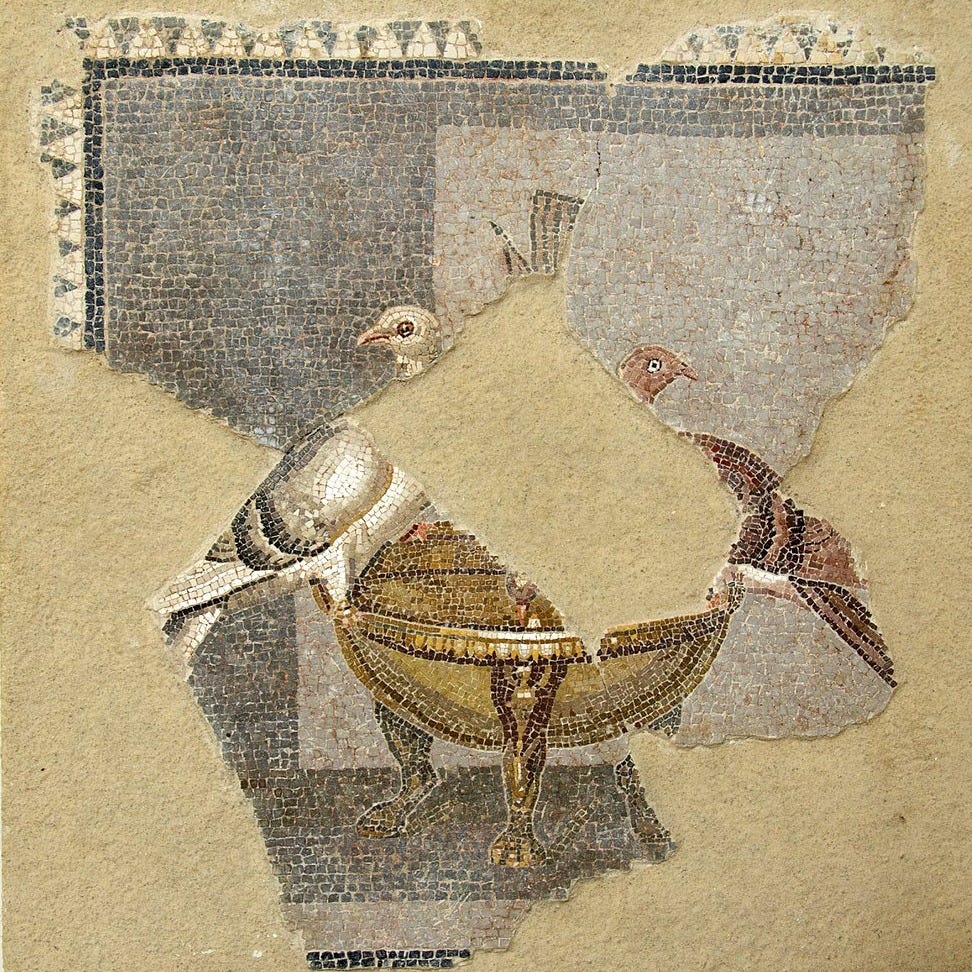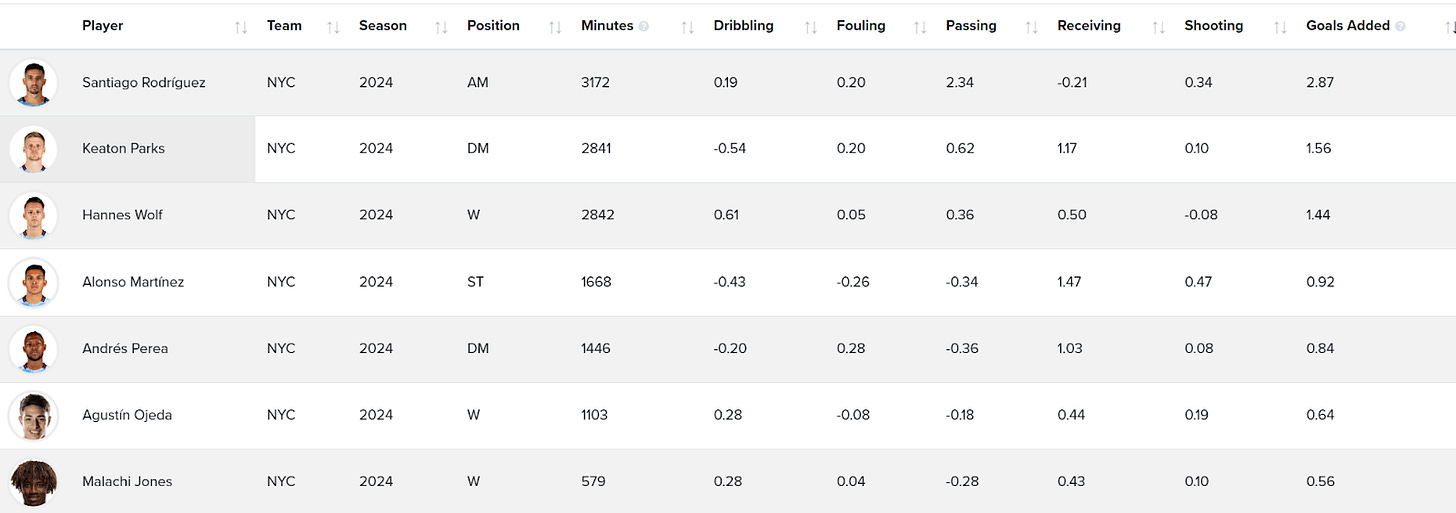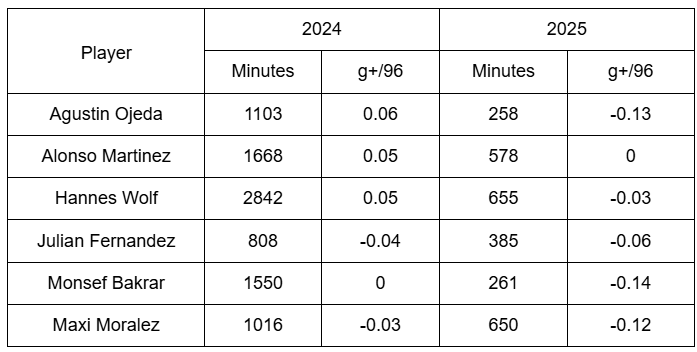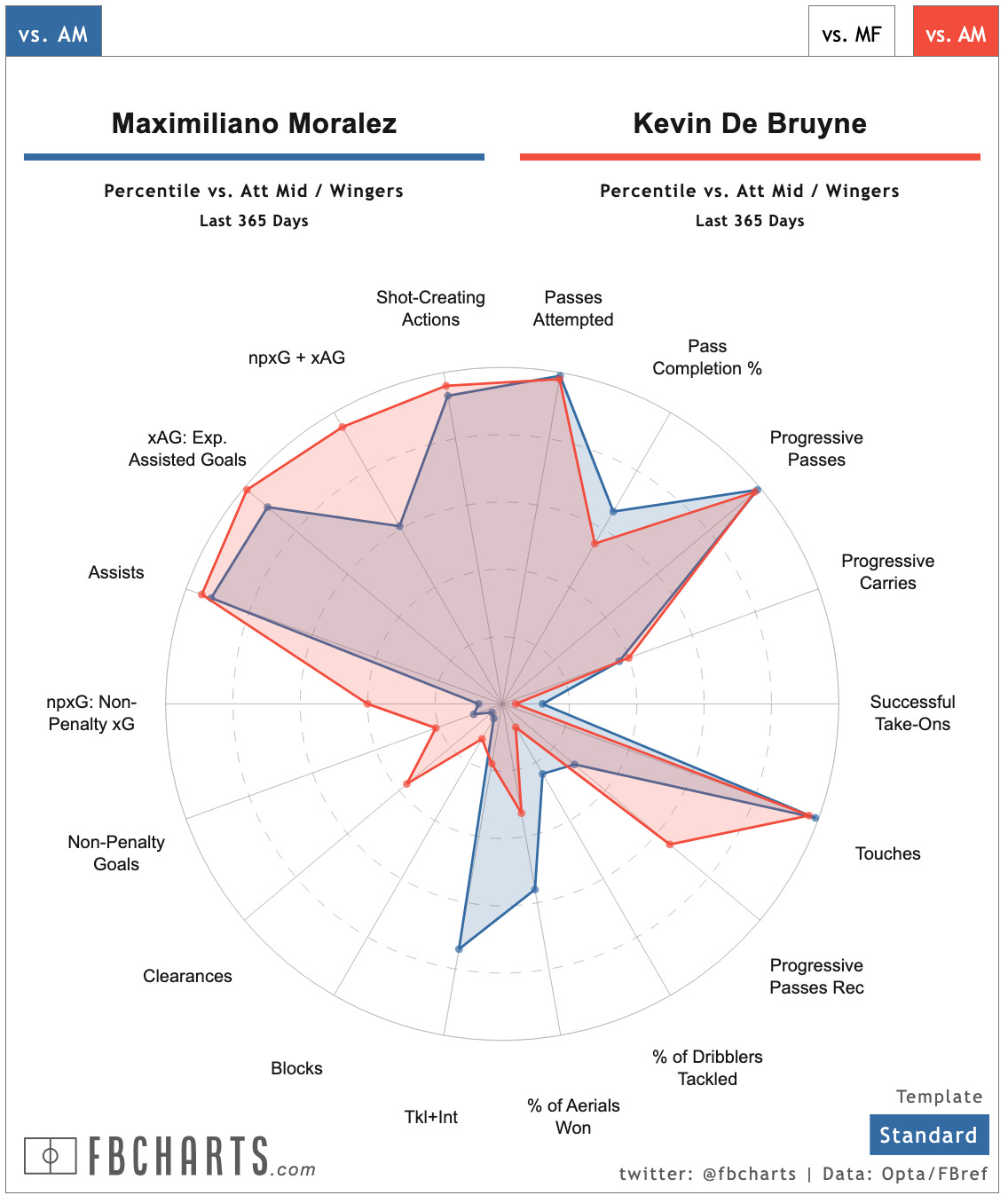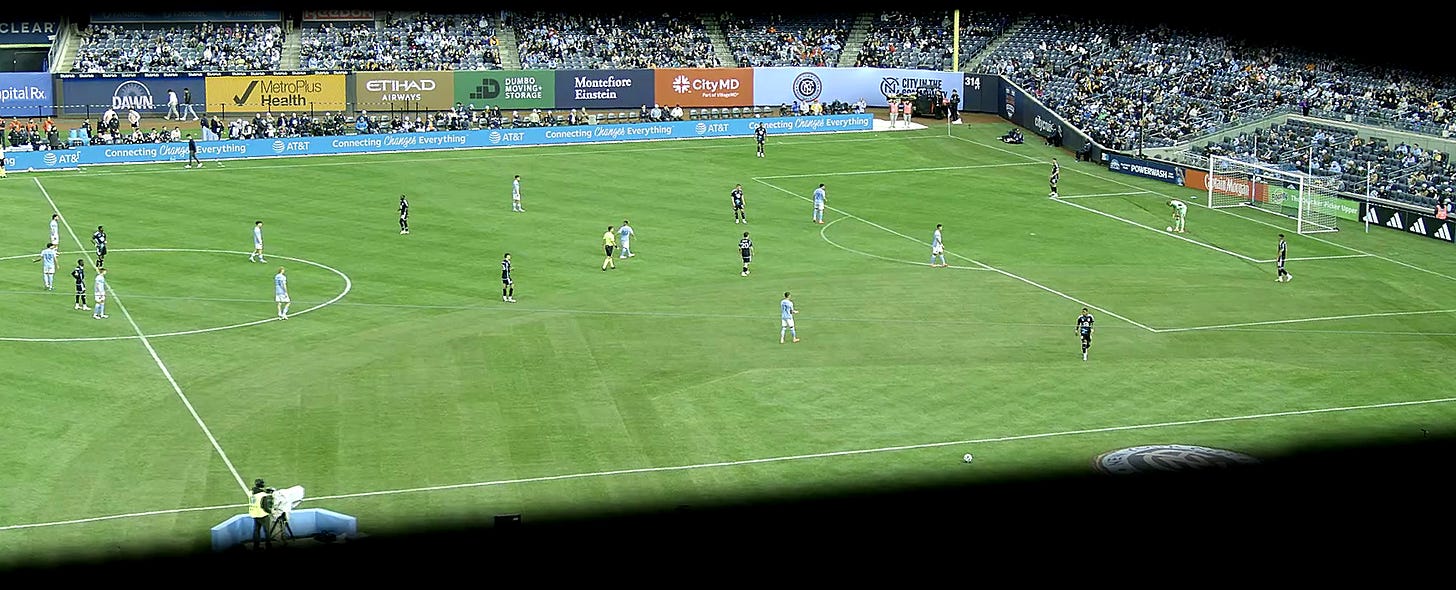Pigeon Post: Hope, Hype, and Harsh Truths Edition
Pascal Jansen sharpens the system, raises standards, and gives the kids a real shot—but don’t start planning the parade.
It’s seven games into the season, and if you follow New York City Football Club, there are many reasons to feel both hopeful and despondent. The crew at The Outfield addresses your hopes and fears:
Is there any sort of statistical evidence that supports David Lee’s claim that our team “can compete with every team in the league?” -BC19
Kevin Nelson: The answer depends on how you define “a team that can compete with anybody in the league.” NYCFC has faced four teams ranked in the top eight in non-penalty expected goal differential (npxGD) per 96 minutes, managing one win and two draws. By the numbers, they’ve been “competitive.” But performances against Inter Miami and Columbus felt more like Little Giants—with Rick Moranis sneaking out a win over Ed O’Neill “one time.” In those games, NYCFC was out-xGed 4.07 to 1.13. If not for a first-half red card or Columbus forgetting how to shoot on target, the scorelines could’ve been worse.
Still, their bend-don’t-break showings give some credence to David Lee’s claim that NYCFC can compete with any team on any given day. But that phrase does a lot of work. The real question is whether they can compete for trophies. That case is much harder to make.
In 2024, under Nick Cushing, NYCFC posted solid underlying metrics—12th in npxGD and 6th in goals added (g+). That team featured James Sands and Santiago Rodriguez, neither of whom were replaced for 2025. Unsurprisingly, the team has regressed—currently ranking 24th in npxGD and 28th in g+.
Lee may be evaluating the squad based on potential. The club spent over $20 million on Jovan Mijatovic, Agustín Ojeda, Julián Fernández, and Mounsef Bakrar, and brought in Hannes Wolf from the Bundesliga on the club’s second-highest salary. But Mijatovic’s stock has plummeted (oops), Bakrar has been benched, and the others have flashed promise without consistency. Every attacker with at least 2.5 90s this season is underperforming compared to 2024.
Some growing pains are expected under a new coach, but this doesn’t look like a championship roster. Maxi Moralez, at 38, is still the team’s primary creator, and no major reinforcements arrived this offseason. NYCFC seems to be betting on a playoff run fueled by a forgiving format and postseason chaos. But counting on randomness across four playoff rounds is a stretch—though Lee is free to dream.
According to the American Soccer Analysis model by Matthias Kullowatz, NYCFC’s title odds have dropped from 4% at the start of the season to 1%, now 18th-best in the league. Unless Moralez rewinds the clock or Ojeda, Fernández, or Wolf catch fire, the MLS Cup feels out of reach.
On any given day? Sure. Over a full season? Not quite.
What’s our hopefulness rating on Agustín Ojeda and Julián Fernández? - Matthew Doyle
Justin Egan: My hopefulness rating for Ojeda remains high, around 8/10, and it could increase if he manages to escape Pascal Jansen’s doghouse and secures a spot in the starting lineup in the coming weeks, which I expect he will.
Currently, NYCFC’s offensive struggles this season stem largely from a lack of players who can combine effectively in possession and take on defenders in 1v1 situations. These were qualities heavily relied on from Santiago Rodriguez last season. As it stands, Ojeda is the only player on the roster capable of fulfilling both of these tasks.
Let's consider Alonso Martinez’s scissor kick goal from Matchday 6. That beautiful finish would not have been possible without Ojeda's precise 1-2 passing, which created space for Keaton Parks’ run into the box. It was a vintage display of the goal-scoring machine NYCFC was before 2023.
In the match against Minnesota, Ojeda was the only player praised by Jansen in his post-game remarks. Jansen highlighted Ojeda’s ability to break down defenders 1 on 1 and create danger by getting the ball to the touchline multiple times during the press conference. This unique skill set will likely make him a fixture in the starting lineup. Just don’t be late to the match tonight, kid!
Chris Campbell: Two weeks ago, my hopefulness rating for Fernández was a 6 or 7 out of 10. The young Argentine had a goal and two assists in his previous four matches, suddenly showing surprising proficiency with his right foot. But after he was subbed off in the first half against Minnesota, that rating dropped by two notches.
Now in his third year at NYCFC, Fernandez still struggles in one-on-one situations, relying mostly on runs behind the back line and quick transitions. He’s completed just 3 of 16 take-ons, and his lone goal came on a fast break. The tight confines of Yankee Stadium and Citi Field limit those opportunities, making one-on-one ability even more essential. Though his off-ball runs are strong and purposeful, he lacks the strength to fend off defenders and the savvy to combine in tight areas.
These are traits that often develop with time. Fernandez was still a teenager when NYCFC signed him during the 2023 season, but under Cushing, he logged under 1,000 minutes—hardly enough for meaningful development.
He’s had more chances under new manager Jansen, though it took Ojeda’s tardiness to kickstart his recent run of starts. Through seven games in 2025, Fernandez has logged 350 minutes and five starts—just one shy of last year’s total.
But those minutes may now be in jeopardy. Jansen replaced him with Bakrar, a striker, and praised Ojeda’s second-half performance. With Malachi Jones possibly returning from injury and new arrivals likely in the summer window, opportunities could dry up quickly.
I still believe Fernandez can become a 10-plus goal contributor for NYCFC. But I’m starting to worry he won’t get enough consistent minutes to reach that potential.
I keep hearing about Maximo Carrizo, but I don’t know much about him. In your estimation, what’s his genuine potential? -Abdallah Nabeel Rashid
Paul Harvey: Maximo Carrizo remains the youngest player ever to sign a pro contract in Major League Soccer—a feat made more impressive by the rising youth trend in signings. Three years on, public interest in his development is only natural. But being a diminutive, left-footed Argentine brings its own set of expectations.
Even in MLS, 17-year-olds rarely earn significant minutes. Carrizo is also an attacking midfielder—a role that demands more than most. Across the league, few American CAMs are regular starters, let alone teenagers. While Moralez likely won’t play full 90s all season, it’s more likely NYCFC brings in another starter than promotes Carrizo outright. Anything above 500 minutes this year would be a major success.
There are misconceptions about Carrizo’s game. Messi comparisons come easily given his stature, nationality, and footedness—but he’s a different player. He’s more ball-secure than bold, showing above-average efficiency in progressive actions per touch and per turnover. Though small, he’s strong and athletic enough to shield the ball from larger defenders. Still, his xG and xA numbers are modest—he connects play well, but his end product remains a work in progress.
Does he have a place on this team? Maybe. But with NYCFC’s current chance-creation struggles, Carrizo isn’t a quick fix. As Arsène Wenger once said: you pay for young players in points. Whether Jansen is willing to take that risk remains to be seen.
For now, Carrizo captains the best USA U17 team since Christian Pulisic’s era—and maybe ever. He’s a near-lock for the U17 World Cup in Qatar this November. If even half the top players are released, the U.S. could be a favorite. A strong MLS season and a big tournament could push Carrizo toward even bigger things.
Any crumb or leak or whisper of news about a signing? How can we squirrel away so much GAM when we have such a lackluster starting lineup? -CCMore
Luis Gomez: I don’t know. I don’t think anybody knows. Lee has made loose, non-committal throat-clearing noises at filling out the rest of the squad during the summer window, but the fact remains that New York City FC is sitting on a veritable Scrooge McDuck-sized pile of G.A.M. and has done fuck all with it. One can only assume, based on our recent transfer history and current non-action, that one of the following options is true:
Lee is a weaselly ignoramus who’s bad at his job
Someone at C.F.G. corporate saw how fucking disastrous our last, like, four transfer deals were and told the front office to stop spending money
Lee is actually doing a Smaug-cosplay-LARP thing, which is why he’s hoarding cash like the King Under the Mountain
In the meantime, take a look at this chart and have a cry with me:
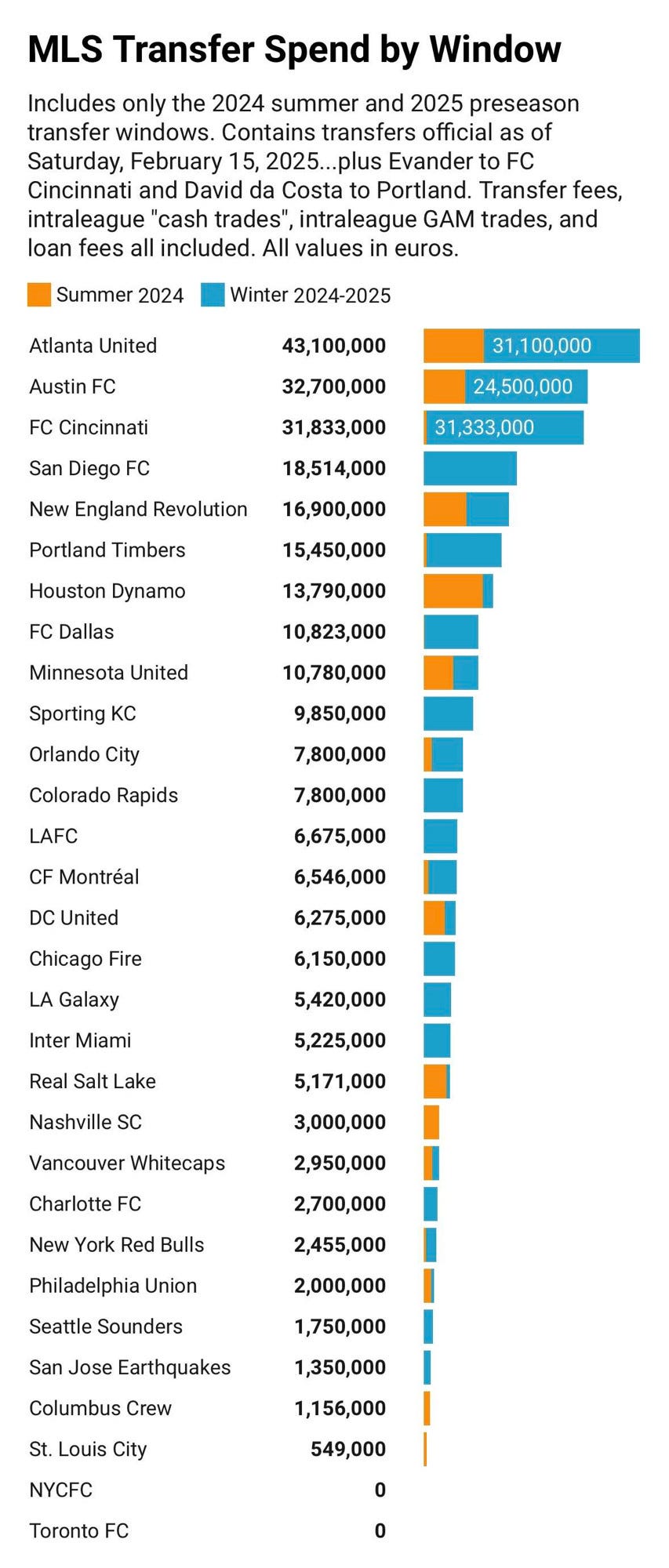
Do people think that NYCFC is interested in signing Kevin De Bruyne? Would this be a good signing performance-wise and money-wise? -Andy Drelick
Alec Kossoff: While it’s impossible to know which players NYCFC is targeting, Kevin De Bruyne would be an excellent fit for MLS and would likely thrive here. However, he doesn’t align with Lee’s typical profile—Lee has prioritized high-upside youth signings as the club has shifted toward a development model. Still, with the new stadium opening in 2027, now may be the perfect time for a marquee addition.
Like any designated player (DP) signing, bringing in De Bruyne would come with clear pros and cons.
At 33, De Bruyne remains one of the Premier League’s top midfielders. He’s made 28 appearances for Manchester City this season and continues to rank in the top 1% for attacking and passing metrics among midfielders. While he’s lost a step in pace, his intelligence, vision, and ball progression remain elite.
His experience would also be invaluable. NYCFC has a promising group of young players who would benefit from his leadership, particularly in high-stakes moments—an area where the team has recently struggled.
From a marketing perspective, while NYCFC may not rely heavily on name recognition, MLS as a league thrives on iconic signings. With the stadium launch ahead, a high-profile move like De Bruyne’s could elevate the club’s visibility and league-wide relevance.
However, De Bruyne’s age and injury history are concerns. He hasn’t completed a full season in years, and while MLS is less technical than the Premier League, it’s physically demanding. Jansen’s system requires midfielders to press and cover ground—raising doubts about whether De Bruyne can meet those demands over a full season.
There’s also a tactical dilemma. Moralez, a club legend but now 38, still plays a significant role. A midfield pairing of Moralez and De Bruyne raises questions: Who defends? While they could learn to complement each other, neither is naturally defensive, placing extra pressure on holding midfielders like Keaton Parks, Johnny Shore, and Justin Haak.
DP signings are always high-stakes. Even legends can falter if the environment isn’t right—Toronto FC is a recent reminder. With limited DP slots and budget constraints, the club must be certain De Bruyne is motivated to compete, not just looking for a soft landing or an escape.
It’s hard to believe Lee hasn’t at least explored the possibility. If De Bruyne were to land in New York, it would be thrilling to see him don the familiar blue.
So far, what differences are we seeing between Pascal Jansen and Nick Cushing? -Shwafta
Haylon Harroo: Much of what has worked under Jansen stems from his clear tactical identity, but the groundwork was already in place. The more meaningful change has been cultural—a reset in mentality and performance evaluation, rooted in causality. NYCFC hasn’t been transformed so much as refined. Jansen has dotted the i’s and crossed the t’s.
NYCFC recommitted to pressing in 2023 under Cushing, lowering their PPDA from 11.47 to 8.37 by season’s end. Jansen has pushed it further to 7.9—seventh best in MLS and the league’s best at home, as noted by Union coach Bradley Carnell. His press is more precise, and he’s deployed players more effectively. Shifting Hannes Wolf to a traditional role on the left, for example, has helped unlock direct attacking play to match the team’s defensive urgency.
I would like that we have a bulletproof mindset… A bulletproof mindset, in my opinion, makes you work from a standard that you feel like you can handle anything in any stadium under any circumstance. - Pascal Jansen
The early results speak to that mindset shift. NYCFC took 8 points from their first five games (three away). In 2024, they earned just 3 points in the same span. Against Miami and Columbus, NYCFC held on for road draws—games they likely lose under Cushing. The Atlanta match could’ve been a 3–1 win if not for avoidable errors. Growing pains remain, but the foundation is stronger.
Bakrar’s finishing woes in 2024 became a running story—nearly four xG without a goal through ten matches. Yet Cushing stuck by him, praising work ethic and training form. By the time changes came, confidence was already eroded.
Jansen, by contrast, benched Hannes Wolf just three games in for a dip in form. He later sat Ojeda for arriving late. His approach is clear: system and standards over patience and potential. Even Carrizo and Reid’s historic debuts in Columbus were treated as routine 73rd-minute substitutions. No ceremony—just do your job.
Under Cushing, talented young players were underused, which clashed with the club’s development model. In 2024, Fernández played 22% of squad minutes; Ojeda, 30.2%. Under Jansen, those numbers are up to 55.6% and 34.8%, respectively. The message: playing time is earned.
While Cushing laid the tactical foundation, Jansen has built on it with something less measurable: accountability. His NYCFC isn’t just pressing harder or attacking more directly—it’s thinking sharper and expecting more. There’s now a culture that rewards performance, not just potential.
What do you guys think about a formation change? 3-4-1-2 or 5-3-2 would make us more solid defensively and give attacking players more space to operate in on the counter? -Aligatorhugbus
JE: I can’t see NYCFC adopting a formation without wingers. Wingers have been a core part of NYCFC’s tactical identity since day one. The club has invested significant resources in Ojeda, Fernandez, and Wolf, and Jansen’s tactics have predominantly centered around the 4-2-3-1 and 4-3-3 formations, where wingers play a crucial role both in pressing and possession. A 3-4-3 formation seems like a stronger possibility, but the challenge lies in NYCFC’s current lack of depth in midfield. Moralez must be on the field in this iteration of NYCFC, and asking him to play a box-to-box role seems to be a great way to grind a senior citizen into dust when you have to have him last the entire season.
That said, Jansen switched to an intriguing 3-ATB system last week while chasing Minnesota’s two-goal lead. He transitioned from a 4-2-3-1 to a 3-2-3-2 formation, adding another striker at the expense of fullbacks.
With Minnesota sitting back, adding another player in the box helped create space for Ojeda and Wolf to operate more effectively out wide. There was certainly a risk in asking Thiago Martins to defend counterattacks largely on his own, but conceding a third goal likely wouldn’t have changed the outcome of the match. It will be interesting to see if we see a similar setup situationally in the future. ❧
Image: Museum of Delos, Mosaic with pigeons



